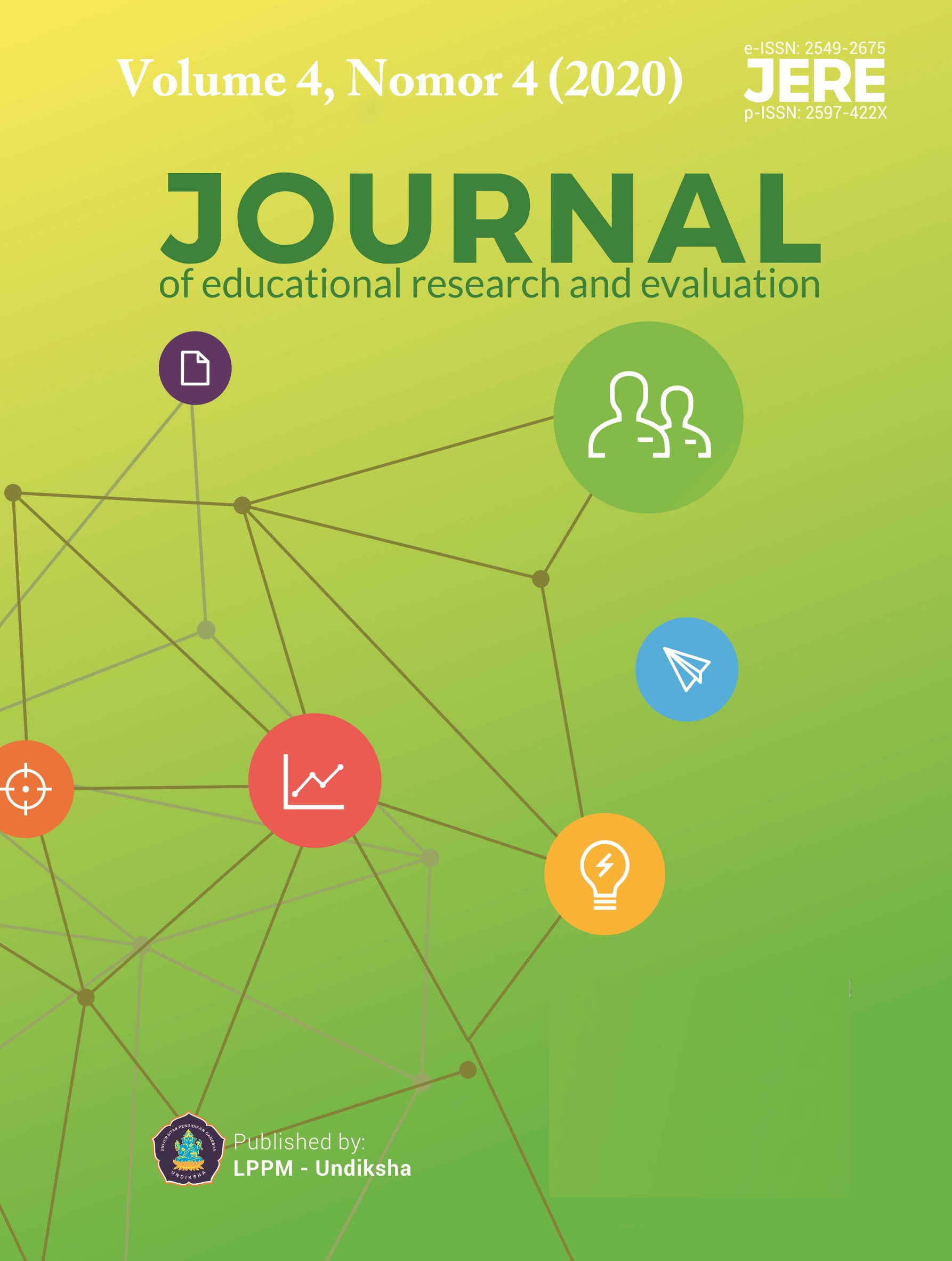The Students’ Reading Competency on High Order Items in the Junior High School
DOI:
https://doi.org/10.23887/jere.v4i4.27720Keywords:
Critical Reading, High Order Items, Reading CompetencyAbstract
This study aims to describe and compare the students’ reading competencies on high order items across classes, text genres, and reading indicators in SMPN 1 Ubud. The design implemented was descriptive and comparative research. The population of this research was the seventh grade students of SMPN 1 Ubud and the samples were four intact classes which determined through Cluster Random Sampling. The data were gathered by using Reading Competency Test. The collected data were then analysed descriptively and then inferentially by implementing a parametric statistics, namely: 1) central tendency measures, 2) measures of dispersion, and 3) simultaneous comparison. The result shows the students’ reading competency categorized as poor reading competency and there was not significance different in students’ reading competencies on high order thinking items across classes, text genres, and reading indicators. Poor reading competencies implies both of the students and EFL teachers to train intensively and extensively in reading process in order to have ability in determining the reading indicators of both descriptive and recount texts.
References
Brown, H. D. (2004). Language Assessment Principles and Action Practices. New York: Longman.
Indrilla, N. (2018). The Effectiveness of Scientific Approach And Contextual Teaching And Learning Approach In Teaching Writing. Lingua Cultura, 12(4), November 2018, 405-413 DOI: 10.21512/lc.v12i4.4452.
Kartikawati,Y., Fauziati, E., Hikmat, M. H. (2015). The Implementation of Scientific Approach In Teaching English At The Eight Grade Of Smp Muhammadiyah 10 Surakarta In 2014/ 2015 Academic Year: A Naturalistic Study. English Department, Muhammadiyah University of Surakarka.
Kemendikbud, 2013. Kerangka Dasar Kurikulum 2013. Kementerian Pendidikan dan Kebudayaan Direktorat Jendral Pendidikan Dasar. Jakarta.
Latifa, N. (2018). Teaching Narrative Text by Using Preview, Question, Read, State, and Test (PQRST) Technique. English Education Journal (EEJ). 9(2), 243-260.
Muhlison. (2011). The effectiveness of contextual teaching and learning to teach reading comprehension (An experimental study at the eight grade students of MTs At-Thosari Kalirejo Ungaran Timur in academic year of 2010/2011). (PhD thesis). Semarang: IAIN Walisongo.
Novitayanti, E. (2017). Pendekatan Saintifik Dan Kontekstual Dalam Pembelajaran Literasi Sains Di Sekolah Dasar. Prosiding Seminar Nasional15 Maret 2017.
Nurgiyantoro, B. (2013). Penilaian Pembelajaran Bahasa Berbasis Kompetensi. Yogyakarta: BPFE Yogyakarta.
OECD. (2012a). Excellence through Equity: Giving Every Student the Chance to Succeed (Volume II). (2012). PISA 2012 Results in Focus What 15-year-olds know and what they can do with what they know. Organization for Economic Co-operation and Development.
OECD. (2012b). Ready to Learn: Students' Engagement, Drive and Self-Beliefs (Volume III). (2012). PISA 2012 Results in Focus What 15-year-olds know and what they can do with what they know. Organization for Economic Co-operation and Development.
OECD. (2012c). What Makes Schools Successful? Resources, Policies and Practices (Volume IV). (2012). PISA 2012 Results in Focus What 15-year-olds know and what they can do with what they know. Organization for Economic Co-operation and Development.
OECD. (2012d). What Students Know and Can Do: Student Performance in Mathematics, Reading and Science (Volume I). (2012). PISA 2012 Results in Focus What 15-year-olds know and what they can do with what they know. Organization for Economic Co-operation and Development.
OECD. (2015). PISA 2015 Result in Focus. Organization for Economic Co-operation and Development.
OECD. (2018a). PISA Result in Focus. https://www.oecd.org/pisa/pisa-2015-results-infocus.pdf.
OECD. (2018b). What Is PISA? http://www.oecd.org/pisa/
OECD. (2018c). The future of education and skills, Education 2030. https://www.oecd.org/ education/2030/E2030%20Position%20Paper%20(05.04.2018).pdf.
Pratiwi, I. (2019). Efek Program Pisa Terhadap Kurikulum Di Indonesia Pisa Effect On Curriculum In Indonesia. DOI : 10.24832/jpnk.V4i1.115
Schleicher, A. (2018). PISA 2018 Insight and Interpretation. Organization for Economic Co-operation and Development.
Semerci, N, & Sumerci, Ç (2017). The Effect of Teacher Candidates' Critical Literacy Levels on Their Media Literacy Levels. Universal Journal of Educational Research 5(12A): 13-18, 2017 http://www.hrpub.org DOI: 10.13189/ujer.2017.05130.
Sezer, N. & Yılmaz Sert, N. (2013). “Online Medya Okuryazarlığının Yetişkinler İçin Önemi “Online Haber Sitelerindeki Bannerlara Yönelik Bir İnceleme”, Online Academic Journal of Information Technology, 4 (13), 63-78
Downloads
Published
How to Cite
Issue
Section
License
Authors who publish with the Journal of Evaluation and Research in Education (JERE) agree to the following terms:
- Authors retain copyright and grant the journal the right of first publication with the work simultaneously licensed under a Creative Commons Attribution License (CC BY-SA 4.0) that allows others to share the work with an acknowledgment of the work's authorship and initial publication in this journal.
- Authors are able to enter into separate, additional contractual arrangements for the non-exclusive distribution of the journal's published version of the work (e.g., post it to an institutional repository or publish it in a book), with an acknowledgment of its initial publication in this journal.
- Authors are permitted and encouraged to post their work online (e.g., in institutional repositories or on their website) prior to and during the submission process, as it can lead to productive exchanges, as well as earlier and greater citation of published work. (See The Effect of Open Access)











